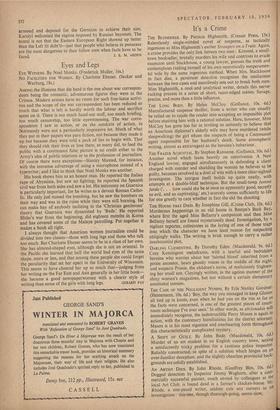Eyes and Legs
EYE WITNESS. By Noel Monks. (Frederick Muller, 16s.)
AMONG the illusions that die hard is the one about war correspon- dents being the romantic, adventurous figures they were in the Crimea. Modern armies have no room for such free-lance activi- ties and the scope of the war correspondent has been reduced so much that what is left is hardly worth the labour and sacrifice spent on it. There is too much hand-out stuff, too much briefing, too much censorship, too little eyewitnessing. The war corre- spondents I saw in action, or on the outskirts of action, in Normandy were not a particularly impressive lot. Much of what they put in their papers was pure fiction, not because they made it up but because alley were told a pack of lies to begin with. That they should risk their lives or lose them, as many did, to feed the public with a continuous false picture is no credit either to the Army's idea of public relations or to the profession of journalism. Of course there were exceptions—Stanley Maxted, for instance, with the immense advantage of using a microphone instead of a typewriter; and I like to think that Noel Monks was another.
His book shows him as an honest man. He reported the Italian rape of Abyssinia, but saw no fighting; he reported the Spanish civil war from both sides and saw a lot. His testimony on Guernica is particularly important, for he writes as a devout Roman Catho- lic. He only just missed the bombing, but he saw the bombers on their way and was in the ruins while they were still burning. He can make hay of anybody inclining to the 'Christian gentleman' theory that Guernica was dynamited by 'Reds.' He reported Hitler's war from the beginning, did eighteen months in Korea and has covered some of the Malaya patrolling. Put together it makes a book all right.
I always thought that American women journalists could be divided into two classes—those with long legs and those who talk too much. But Charlotte Ebener seems to be in a class of her own. She has almond-shaped eyes, although she is not an oriental. In the Pacific she learned that half the world had eyes of the same shape, more or less, and that among these people she could forget the peculiarity that set her apart in the University of Wisconsin. This seems to have cheered her up so much that—judging from her writing on the Far East and Asia generally in her little book— she became a good newspaperwoman with a clearer style of writing than some of the girls with long legs. GERARD FAY


































 Previous page
Previous page